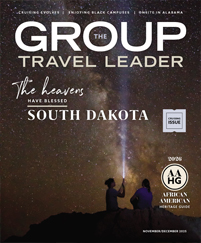In Alabama, every city and town sings with an iconic voice of its own.
That’s what 15 tour operator and travel planner readers of The Group Travel Leader discovered during a five-day familiarization tour to some of Alabama’s most popular destinations early this fall. Hosted by the Alabama Tourism Department, this tour showcased the musicians, dreamers, creatives and activists who have given the state its unique character and inspired some of its most important events.
During the trip, participants visited Huntsville, a high-tech city in Northern Alabama, before traveling south to Tuscumbia, Florence and the Muscle Shoals area, which was the epicenter of Alabama music in the 20th century. They ended the tour in Birmingham, exploring the city’s notable Civil Rights heritage, international cuisine and memorable music.
Follow along on this itinerary to start planning an Alabama tour for your groups.
Day 1
• Arrival in Huntsville
• The Orion Amphitheater
• Stovehouse
• Campus No. 805
• Dinner at Rhythm on Monroe
Tour planners from around the United States flew and drove to Huntsville, the second-largest city in Alabama. After meeting at the Embassy Suites Huntsville, which would be their home for the night, they toured The Orion Amphitheater, a beautiful outdoor performance venue, then explored Stovehouse, a former factory complex that has been repurposed into a hip dining, retail and entertainment district. Next was Campus No. 805, a former school that has also been repurposed for fun and games, followed by a reception at the hotel. They ended the day with a quick stop at Mars Music Hall and a wonderful dinner at the adjacent Rhythm on Monroe.
The Orion Amphitheater
With more than 33 major concerts and 97 cultural events per year, The Orion Amphitheater is the center of Huntsville’s performing arts scene. The 8,000-seat venue is owned by the city of Huntsville and managed by an organization founded by a Mumford & Sons alum. The group took a behind-the-scenes tour, including a photo op on the stage, and had a chance to sample some of the locally made ingredients used in the venue’s signature cocktails.
Stovehouse
Built in the 1920s as a factory manufacturing kitchen stoves, the area that is now known as Stovehouse went through several industrial uses before being redeveloped by a local couple. Today, it’s home to retail boutiques, a food garden and several lively event spaces. The FAM group enjoyed a sip of sparkling wine and craft coffee from a Stovehouse shop before touring other highlights of the 220,000-square-foot facility.
Campus No. 805
In 2014, local developers transformed a former middle and high school building into Campus No. 805, a 13-acre site with 19 tenants ranging from bars and a brewery to a music venue, a salsa club and a laser show company. The group toured the space and walked through Straight to Ale Brewery, the campus’s largest tenant, where they enjoyed seeing the beer production area and a signature speakeasy hidden behind a set of school lockers.
Day 2
• U.S. Space & Rocket Center
• Huntsville Botanical Garden
• Lowe Mill ARTS & Entertainment
• Burritt on the Mountain
• Depart for Tuscumbia
• Dinner at Rattlesnake Saloon
The second day of the trip began with a tour of Huntsville’s U.S. Space and Rocket Center, the most visited attraction in Alabama. From there, the group went to Huntsville Botanical Garden, where they enjoyed a tour of the beautiful grounds and an on-site lunch. Next was a tour and a cigar-box guitar lesson at Lowe Mill ARTS & Entertainment, another industrial reuse venue. The group ended their time in Huntsville with a visit to the historic home and village overlooking the city at Burritt on the Mountain. From there, they made the two-hour journey south to Tuscumbia, where they enjoyed a delicious dinner — and live music from a pair of Muscle Shoals all-star performers — at Rattlesnake Saloon, a unique restaurant located inside a cave. They ended the day at Renaissance Shoals Resort & Spa, a newly renovated property honoring the area’s musical heritage.
U.S. Space and Rocket Center
A 500-foot-tall replica of a Saturn V rocket stands outside the U.S. Space and Rocket Center, the world’s largest space museum. Inside, guests got to see a real Saturn V — one of hundreds of space artifacts on display — during tours guided by former NASA employees. Other highlights include an Apollo lunar landing module, a moon rock and a planetarium with fascinating interactive shows. The center is also home to the world-famous Space Camp program for students.
Huntsville Botanical Garden
Opened in 1986 by a group of 12 local residents who petitioned the city for land, Huntsville Botanical Garden has become one of the most beautiful sites in town. Across its 118 acres, visitors see beautiful floral displays, water features, and gorgeous live oaks and crape myrtles. There’s also a conservatory, a seasonal butterfly house and a rock garden maze with a giant troll created by world-famous Danish sculptor Thomas Dambo.
Lowe Mill ARTS & Entertainment
The area known as Lowe Mill had multiple industrial uses throughout the 20th century. Today, though, it is home to Lowe Mill ARTS & Entertainment, the largest privately owned artists community in the United States. Visitors can attend workshops specializing in everything from painting to puppets, with opportunities to meet the artists and purchase their creations. After a tour, the FAM group had a wonderful hands-on music lesson with a couple that crafts guitars from old cigar boxes.
Burritt on the Mountain
In the 1930s, an eccentric doctor named William Burritt purchased 167 acres on top of Round Top Mountain overlooking Huntsville and built a home there. Today, that site is preserved as Burritt on the Mountain, where visitors can tour the one-of-a-kind X-shaped house and a collection of other historic buildings brought to the site. Groups can also see live farm animals, a restored historic schoolhouse and beautiful views of the city below.
Day 3
• FAME Recording Studios
• Muscle Shoals Sound Studio
• Alabama Music Hall of Fame
• Lunch at Champy’s World Famous Fried Chicken
• W.C. Handy Birthplace, Museum & Library
• Helen Keller Birthplace (Ivy Green)
• Depart for Birmingham
• Dinner and tour at Vulcan Park & Museum
Music history dominated the morning activities on the third day of the trip. The group made back-to-back visits to FAME Recording Studios and Muscle Shoals Sound Studio, the two major sites where dozens of hits were recorded in Alabama. Next came a visit to the Alabama Music Hall of Fame, followed by a fried chicken lunch. They wrapped up their time in the area with visits to the birthplaces of W.C. Handy, known as the “Father of the Blues,” and Helen Keller. The group then took a two-hour drive south to Birmingham, where they caught sunset views and a private dinner at the city’s famous Vulcan Park & Museum.
FAME Recording Studios
In the 1960s and ’70s, music legends such as Aretha Franklin, Etta James, The Osmonds and The Allman Brothers recorded massive hits at FAME Recording Studios in the sleepy town of Muscle Shoals. Today, the studios are both an active recording space and a destination for music lovers, who can tour the studio spaces and hear the stories of founder Rick Hall and the many legendary artists who recorded there.
Muscle Shoals Sound Studio
After several years of working at FAME, a group of session musicians known as the Swampers moved across town to open Muscle Shoals Sound Studio, where they played on tracks recorded by luminaries such as Cher, Bob Seger and Paul Simon. Though their operation has since moved to other areas, the original nondescript studio building has been restored to its 1970s heyday and offers a detailed took into the area’s music history.
Alabama Music Hall of Fame
More than 80 musicians who were born in Alabama — or who lived at least 30 years there — have been inducted into the Alabama Music Hall of Fame. At the museum in Tuscumbia, visitors can learn about these musicians, ranging from W.C. Handy to Percy Sledge and Hank Williams, and see instruments, gold records and other memorabilia from their careers. The group especially enjoyed walking through one of the museum’s main exhibits: the first tour bus used by the country band Alabama.
W.C. Handy Birthplace, Museum & Library
In 1873, a baby boy named William Christopher Handy was born to a formerly enslaved man and his wife in a two-room cabin in Florence. W.C. Handy grew up to become one of the most prolific musicians and composers of the early 20th century and is now regarded by music historians as the “Father of the Blues.” The group visited that cabin, which is now preserved as a historic site with an adjacent museum, and learned about Handy’s life and legacy.
Helen Keller Birthplace
For decades, young students around the country have been inspired by the story of Helen Keller, the girl born deaf and blind who grew up to become an influential speaker, writer and advocate. Groups traveling in Tuscumbia can visit Ivy Green, the home where Keller was born and lived her early life. During the visit, they’ll see the family water pump and other sites made famous in “The Miracle Worker,” the story of Keller and her lifelong aide and teacher, Anne Sullivan.
Vulcan Park & Museum
Standing on Red Mountain overlooking the city, a massive statue of the Roman god Vulcan has become an iconic Birmingham landmark. Built in 1904 for the World’s Fair, the 56-foot-tall sculpture is the world’s largest cast-iron statue. In the on-site museum, visitors learn about Brimingham’s history in industrial metalwork, as well as its Civil Rights history. The group enjoyed a private catered dinner in the museum and met an Olympic gold medalist who now works there.
Day 4
• Gospel & Grits at 16th Street Baptist Church
• Birmingham Civil Rights Institute
• Kelly Ingram Park and A.G. Gaston Motel
• Alabama Jazz Hall of Fame
• Greek food festival at Holy Trinity-Holy Cross Greek Orthodox Cathedral
• Cooking by Kessler at Grand Bohemian Mountain Brook Hotel
The entire fourth day of the trip took place in Birmingham. The morning began with an unforgettable musical performance, followed by breakfast and a tour at 16th Street Baptist Church, one of the city’s most important Civil Rights sites. The group then toured the Birmingham Civil Rights Institute and explored more Civil Rights history at the nearby Kelly Ingram Park and A.G. Gaston Motel. They then took advantage of a Greek food festival for a traditional meal and a tour at Holy Trinity-Holy Cross Greek Orthodox Cathedral. After some time to refresh at the Hampton Inn Downtown Tutwiler, they headed to the Grand Bohemian Mountain Brook Hotel for an elegant cooking class and dinner experience.
16th Street Baptist Church
On a Sunday morning in 1963, white supremacists planted a bomb outside of 16th Street Baptist Church, one of Birmingham’s most historic Black congregations. The bomb exploded, killing four girls. The tragedy caught the eyes of the nation and helped galvanize the growing Civil Rights Movement. During their visit, the FAM group heard a performance by the Birmingham Youth & Young Adult Fellowship Choir, which was fresh from appearing on America’s Got Talent, then enjoyed a catered breakfast and a tour of the sacred site.
Birmingham Civil Rights Institute
Next door to the church, the Birmingham Civil Rights Institute immerses visitors in the issues of the Civil Rights Movement and the role that Birmingham played in the events. Visitors see displays illustrating the injustices of segregation; touch the bars from behind which Martin Luther King Jr. penned his famous “Letter from a Birmingham Jail”; and learn about the leaders and everyday activists from across the state whose courage helped to make civil rights a reality for Black citizens.
Kelly Ingram Park and A.G. Gaston Motel
Just outside the church and Civil Rights Institute, Kelly Ingram Park was the site of a 1963 Civil Rights march that turned violent when police unleashed water cannons and dogs on demonstrators. Today, the park has statues honoring the victims of the church bombing, as well as other sculptures and monuments telling stories of the struggle. The FAM group walked through the park with a guide and visited the adjacent A.G. Gaston Motel, which preserves the site of a business owned by a local Black luminary and Civil Rights supporter.
Alabama Jazz Hall of Fame
Located in the historic Carver Theatre, the Alabama Jazz Hall of Fame memorializes the role that Alabama musicians have played in creating America’s native art form. Inductees include Lionel Hampton, Dinah Washington, Harry Belafonte and Ella Fitzgerald. The museum’s small gallery includes dioramas, instruments and memorabilia, including one of Fitzgerald’s stage dresses and a shirt worn by Belafonte.
Day 5
• Jazz breakfast at Uptown Jazz Lounge
• Depart for home
The FAM group spent their final morning together enjoying a catered breakfast and a private performance at Uptown Jazz Lounge, a venue known for its exciting schedule of live jazz music throughout the week. The featured artist was Ashley Sankey, granddaughter of pioneering gospel singer Katie Sankey, who performed a mix of jazz classics and original songs with the accompaniment of a keyboard player and drummer. After eating, dancing and enjoying the music, the group members said their goodbyes and began their journeys home with the sounds of Alabama’s iconic voices still ringing in their hearts.
For more information in this itinerary or to plan your own Alabama group tour, contact Shawna Faniel with Alabama Tourism at:
334-353-1907









